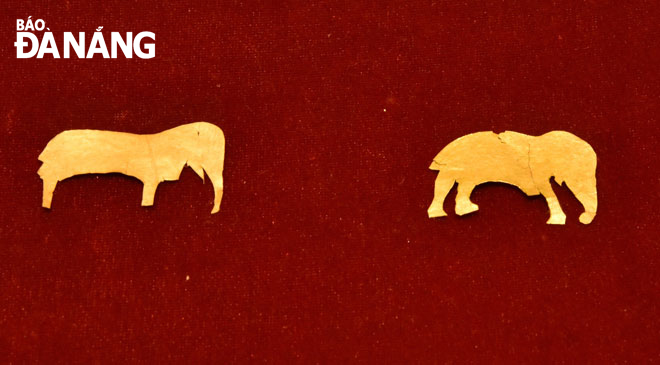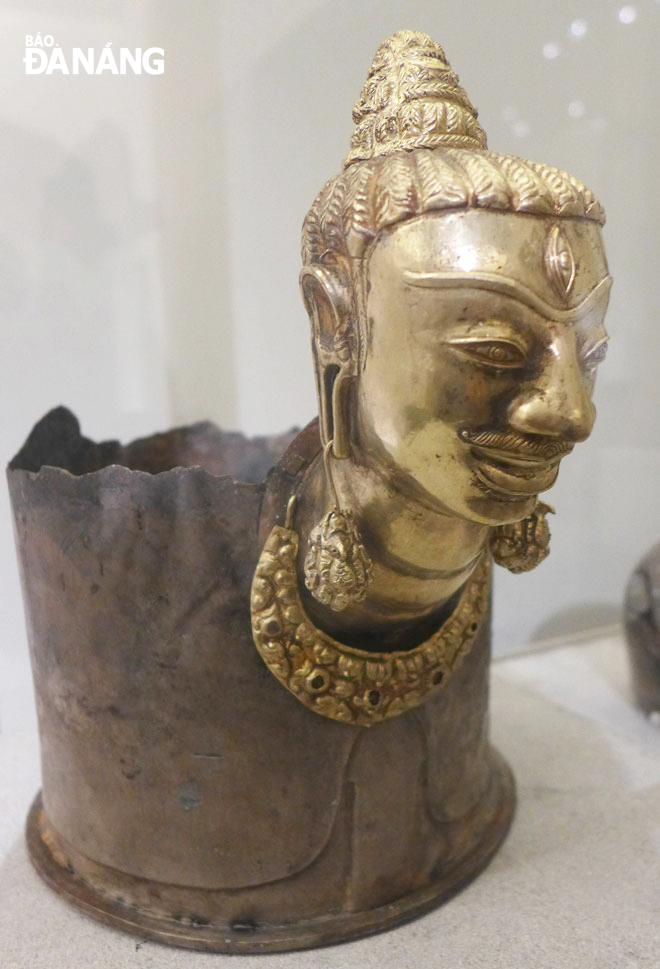The golden artifacts of the early people of the ancient kingdom of Champa not only impress with their abundance but also showcase a remarkable diversity in forms. These artistic masterpieces carry significant aesthetic value, exemplifying the advanced craftsmanship and metallurgical skills achieved by the Champa across different historical periods. Several of these ancient artifacts have earned their national treasure status.

Elephant-shaped gold leaves have been discovered at the Cam Mit Temple, Da Nang. Photo: Tran Tan Vinh
Quang Nam was once the capital and sanctuary land of the Cham people, with such well-known relics as Tra Kieu, My Son, and Dong Duong. Besides, there are gold mines like Bong Mieu and scattered deposits of quartz gold in Quang Nam.
At the Bong Mieu gold mine in Phu Ninh, Quang Nam, there is a traditional stone area, also known as the Cham stone, where ancient Cham people extracted raw ore from the mountains to later refine and extract gold.
This raw material was used in crafting jewelry, tools, statues, and more, for use, exchange, and offerings to spiritual deities. Apart from Quang Nam and Da Nang, other localities in Central Viet Nam have seen archaeologists and local people uncovering valuable ancient artifacts made of gold, such as jewelry, banana stems, and elaborate statues, commonly referred to by locals as "fortunate gold”
In the early 20th century, French archaeologists like Henry Parmentier and Charles Carpeaux, discovered numerous gold artifacts at the Cham relic sites in Viet Nam.
In 1903, during excavations in the My Son relic site, these French archaeologists discovered a ceramic pot containing a wealth of treasures in temple C7. The pot held crowns, necklaces, bracelets, anklets, and toe rings intricately crafted from gold and adorned with precious stones. These jewelry items were intended for adorning a symbol of the Shiva deity at My Son.
At the same time, a sandstone statue of Shiva dating back to the 8th or 9th century was discovered by the French archaeologists in My Son's C7 temple, which was next to the C1 temple. This statue was embellished with a set of gold jewelry.
Archaeologist Henry Parmentier twice discovered valuables belonging to the Champ people at the Ponagar Temple located in Khanh Hoa in February 1906 during a major archaeological dig at the temple. Among the golden findings he discovered were charms, bracelets, rings, vases, elephant and crocodile figurines. This demonstrated where these priceless jewels came from as the Cham people used them as ornaments for their gods during rituals.


Head of the Shiva statue at the Guimet Museum. Photo: Do Truong Giang
Currently, the most valuable remaining golden artifact in Viet Nam is the head of the Shiva Phu Long statue which was recognized as a National Treasure in 2016 by the Vietnamese Prime Minister. This artifact is currently preserved and on display at the Museum of Quang Nam Province. It is a head of the Shiva statue, separated from a Kosa-linga. According to the latest research results, there are at least 9 Kosa-lingas (mostly only the head of the Shiva statue) of this type currently "wandering" abroad.
Among them, the Guimet Museum in France owns 2 artifacts while the Asian Art Museum in Berlin, Germany, owns 1 artifact, and the Asian Civilisations Museum in Singapore owns 3 artifacts. Both artifacts at the Guimet Museum have the Shiva attached to the Kosa.
In particular, both Shiva deity statues have gold earrings. Similar artifacts include the golden Kosa Linga were discovered in Quy Nhon, Binh Dinh Province, dating back to the 12th or 13th century. They are currently preserved and displayed at the Vietnam National Museum of History.
Furthermore, the metal and gold Kosa were found during the 2012-2013 period at the Po Tam temple in Phu Lac Commune, Tuy Phong District, Binh Thuan Province.
In 2012, during the excavation of the Cam Mit Temple located in Hoa Phong Commune, Hoa Vang District, Da Nang, archaeologists discovered elephant-shaped gold leaves. These artifacts are now preserved at the Viet Nam National Museum of History.
In Quang Ngai province, archaeologists have also uncovered Champa gold artifacts at various locations such as Mo Duc and Tay Tra.
In Mo Duc District, at the Tra Veo 3 and Lam Thuong (Tay Tra) relic sites, archaeologists have found 15 jewelry artifacts dating back to the 10th to 12th centuries. The findings included intricately crafted items such as earrings, rings, and ear ornaments, showcasing advanced casting and jewelry processing techniques.
In 2021, a collection of 15 Cham gold artifacts being on display at the Museum of Quang Ngai Province earned their national treasure status.
Currently, in the residence of Princess Nguyen Thi Them, also recognized as Nai Them, and a direct descendant of the Cham king, there is a preserved assortment of Cham royal artifacts that once belonged to the dynasty of kings Po Klaong Manai and Po Klaong Ghul. These monarchs were the final rulers of the Cham kingdom during the 17th and 18th centuries.
The collection encompasses nearly 100 artifacts, comprising a variety of costumes and gold jewelry worn by both the king and queen. The gold hair crown, which represents Queen Po Bia Som, and the crown of King Po Klaong Manai are especially valuable. This is the only crown remaining of the current Cham kings. Queen Po Bia Som was the last person to use this hair crown.
The gold artifacts of the early people of the ancient kingdom of Champa are not only numerous but also diverse in their forms. These artistic masterpieces hold aesthetic value, showcasing their advanced metallurgic and craftsmanship skills throughout different periods. Due to historical variations, many Cham treasures have been lost, and only a small portion is currently preserved in museums or private collections. Some of these gold antiquities of the Cham people are considered precious, invaluable cultural heritage, and they have been recognized by the Prime Minister as National Treasures.
Reporting by Tran Tan Vinh - Translating by Hoai Trang